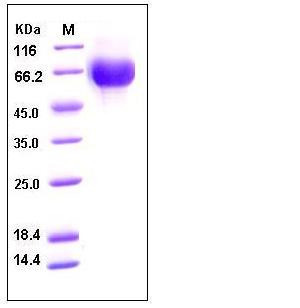Human IL6R / CD126 Protein (His Tag)
CD126,gp80,IL-6R,IL-6R-1,IL-6RA,IL6Q,IL6RA,IL6RQ
- 100ug (NPP1739) Please inquiry
| Catalog Number | P10398-H08H |
|---|---|
| Organism Species | Human |
| Host | Human Cells |
| Synonyms | CD126,gp80,IL-6R,IL-6R-1,IL-6RA,IL6Q,IL6RA,IL6RQ |
| Molecular Weight | The soluble form of recombinant human IL6R consists of 357 amino acids and has a predicted molecular mass of 40 kDa. In SDS-PAGE under reducing conditions, it migrates with an apparent molecular mass of 60-65 kDa due to glycosylation. |
| predicted N | Leu 20 |
| SDS-PAGE |  |
| Purity | > 90 % as determined by SDS-PAGE |
| Protein Construction | A DNA sequence encoding the extracellular domain of human IL6R (NP_000556.1) corresponding to amino acid (Met 1-Pro 365) was expressed with a C-terminal polyhistidine tag. |
| Bio-activity | 1. Measured by its binding ability in a functional ELISA. Immobilized recombinant human IL-6 at 8 μg/mL (100μl/well) can bind recombinant human IL6R with a linear range of 1.25-20.0 ng/ml. 2. Measured by its ability to enhance the IL6 activity on M1 mouse myeloid leukemia cells. The ED50 for this effect is typically 20-80 ng/ml. |
| Research Area | Immunology |Innate Immunity |Monocytes/Macrophages |Monocyte Markers |
| Formulation | Lyophilized from sterile PBS, pH 7.4 1. Normally 5 % - 8 % trehalose, mannitol and 0.01% Tween80 are added as protectants before lyophilization. Specific concentrations are included in the hardcopy of COA. |
| Background | Interleukin 6 receptor (IL-6R) also known as CD126 (Cluster of Differentiation 126) is a type I cytokine receptor. The low concentration of a soluble form of IL-6 receptor (sIL-6R) acts as an agonist of IL-6 activity. In the IL-6R/CD126/IL6R system, both a membrane-bound IL-6R and a sIL-6R protein are able to mediate IL-6 signals into the cells through the interaction of gp130. The resulting IL-6/sIL-6R protein complex is also capable of binding to gp130 and inducing intracellular signalling. Through this so-called 'trans-signalling' mechanism, IL-6 is able to stimulate cells that lack an endogenous mIL-6R. High levels of IL-6 and sIL-6R have been reported in several chronic inflammatory and autoimmune diseases as well as in cancer. |
| Reference |
